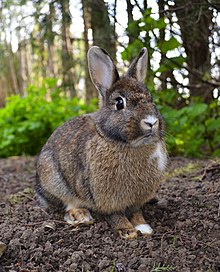| Rabbit | |
|---|---|

| |
| European rabbit (Oryctolagus cuniculus) | |
| Scientific classification | |
| Domain: | Eukaryota |
| Kingdom: | Animalia |
| Phylum: | Chordata |
| Class: | Mammalia |
| Order: | Lagomorpha |
| Family: | Leporidae |
| Included genera | |
| Cladistically included but traditionally excluded taxa | |
Rabbits are small mammals in the family Leporidae (which also includes the hares), which is in the order Lagomorpha (which also includes pikas). The European rabbit, Oryctolagus cuniculus, is the ancestor of the world's hundreds of breeds[1] of domestic rabbit and has been introduced on every continent except Antarctica. It is familiar throughout the world as a wild prey animal, a domesticated form of livestock, and a pet, having a widespread effect on ecologies and cultures. Sylvilagus includes 13 wild rabbit species, among them the seven types of cottontail. Wild rabbits not included in Oryctolagus and Sylvilagus include several species of limited distribution, including the pygmy rabbit, volcano rabbit, and Sumatran striped rabbit.
Rabbits are a paraphyletic grouping, and do not constitute a clade, as hares (belonging to the genus Lepus) are nested within the Leporidae clade and are not included in rabbits. Although once considered rodents, lagomorphs diverged earlier and have a number of traits rodents lack, including two extra incisors. Similarities between rabbits and rodents were once attributed to convergent evolution, but studies in molecular biology have found a common ancestor between lagomorphs and rodents and place them in the clade Glires.
Rabbit physiology is suited to escaping predators and surviving in various habitats, living either alone or in groups that may live in burrows. As prey animals, rabbits are constantly aware of their surroundings, having a wide field of vision and ears with high surface area to detect potential predators. The ears of a rabbit are essential for thermoregulation and contain a high density of blood vessels. The bone structure of a rabbit's hind legs, which is longer than that of the fore legs, allows for quick hopping, which is beneficial for escaping predators and can provide powerful kicks if captured. Rabbits are typically nocturnal and often sleep with their eyes open. They reproduce quickly, having short pregnancies, large litters of four to twelve kits, and no particular mating season; however, the mortality rate of rabbit embryos is high, and there exist several widespread diseases that affect rabbits, such as rabbit hemorrhagic disease and myxomatosis. In some regions, especially Australia, rabbits have caused ecological problems and are regarded as a pest.
Humans have used rabbits as livestock since at least the first century BC in ancient Rome, raising them for their meat, fur and wool. The various breeds of the European rabbit have been developed to suit each of these products; the practice of raising and breeding rabbits as livestock is known as cuniculture. Rabbits are seen in human culture globally, appearing as a symbol of fertility, cunning, and innocence in major religions, historic and contemporary art.
- ^ "Data export". DAD-IS (Domestic Animal Diversity Information System). FAO (Food and Agriculture Organization of the United Nations). 21 November 2017. Retrieved 30 March 2018.